Bayer Leverkusen may have had to let go of the crown jewel from their academy, Kai Havertz, to Chelsea in the summer, but they did bank €85m from this sale, which, during the current COVID-influenced climate, is a substantial sum of money to receive for one player. Additionally, as has been the case with most top German teams in recent years, the departure of one top talent is made up for by the arrival of yet another highly-rated young player making the step up to the senior side. Borussia Dortmund have become something of an expert at this, with a glut of extremely promising young players at their disposal at the moment, and Die Werkself are not too far behind. Havertz’s place in the team has been taken by the 17-year-old wonderkid Florian Wirtz, who has already broken a few age-related records in Germany. He became Leverkusen’s youngest-ever player when he made his debut against Werder Bremen in May 2020, and also became the youngest goalscorer in Bundesliga history when he scored against Bayern Munich in June 2020, although that record was later broken by Dortmund’s Youssoufa Moukoko in December. Wirtz has already drawn comparisons to his predecessor in the team, being called the ‘new Havertz’, and although these comparisons are extremely premature, he has already managed to nail down a place in Leverkusen’s starting XI – no mean feat for a 17-year-old, and is putting in some excellent displays.
This scout report will look at Wirtz’s playing profile and traits in order to gauge his playing style, and what his strengths and weaknesses are.
Playing and statistical profile
Wirtz is a dimunitive player, standing at just 5’9″, although he still has time to grow and develop physically. In terms of his position, the German youngster is primarily an attacking midfielder, and has been used as such by Leverkusen, although he has also played in central midfield, and even at centre-forward on a couple of occasions. He is quite comparable to Havertz in that the Chelsea playmaker also fulfilled various roles for Leverkusen, but both these players are undoubtedly at their best when playing as playmakers, or number 10s. Wirtz’s career heatmap so far illustrates this –
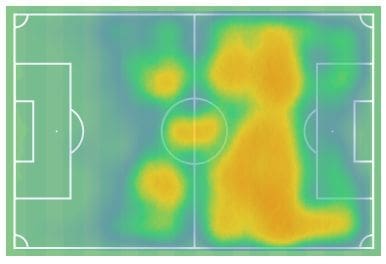
We can immediately see that the vast majority of Wirtz’s actions take place in the space just outside the opposition penalty area, as well as in the wide half-spaces. He is not averse to roaming across the width of the pitch to link up with his teammates, and is extremely effective at playing on the turn, as the analysis will show.
We will now look at Wirtz’s statistics from the Bundesliga season so far, both individually and in comparison with his colleagues from across the league, to get a better idea of his strengths and weaknesses.
At the time of writing, Wirtz had played 1629 minutes in all competitions for Leverkusen, and in terms of raw goalscoring and assist numbers, has been doing extremely well. The teenager has netted six times, with a further four assists, which, in per 90 minute terms, comes out to 0.33 goals per 90 and 0.22 assists per 90, giving him an excellent goal contribution ratio of 0.55/90. This bears out well when we compare him to other Bundesliga central and attacking midfielders, which means that we are only looking at statistics from the Bundesliga. Note that we have only considered players who have played the majority of the season so far as central midfielders and/or attacking midfielders, and that we have excluded all players who have spent less than 800 minutes on the pitch, to get an accurate reflection through these comparisons. All data has been taken from Wyscout.
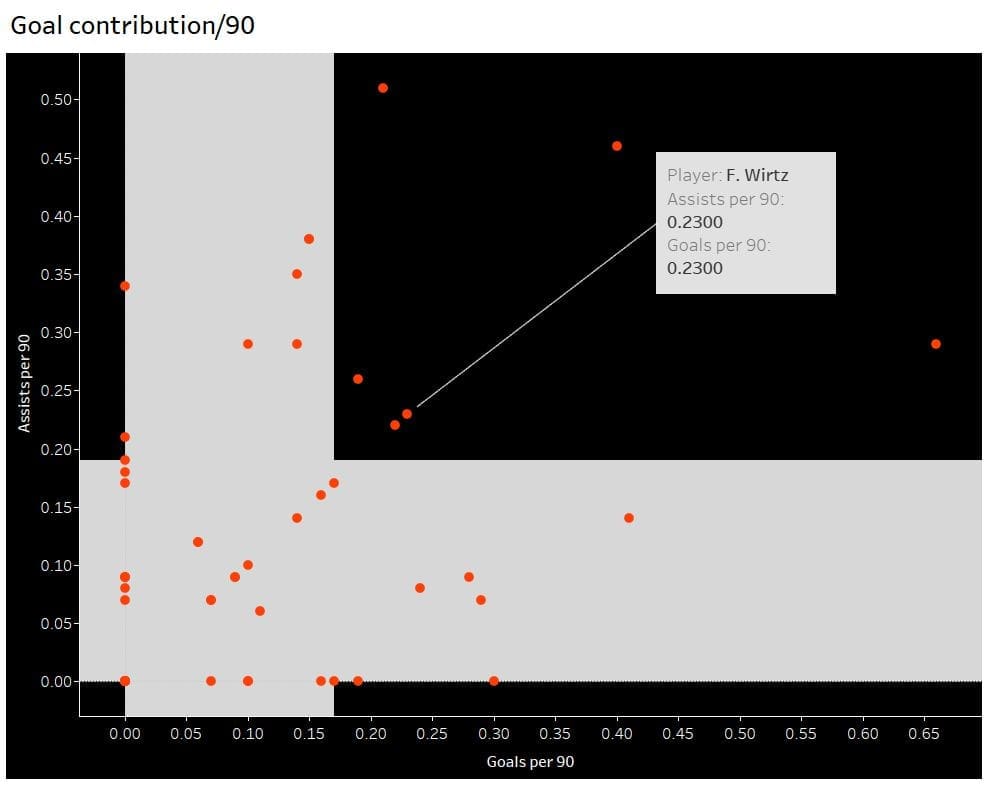
This chart looks at goals and assists per 90 for the above mentioned subset of players from the Bundesliga. The grey areas represent quartiles around the median for both values, so players outside of these areas are doing much better than the rest of their colleagues. We can see that Wirtz is one such player, averaging 0.23 goals and assists per 90 thus far in the Bundesliga, which puts him along the likes of Marco Reus, Joshua Kimmich, Florian Neuhaus, Lars Stindl and Thomas Müller in terms of doing well for both goals and assists per 90 this season. This shows just how immediate an impact Wirtz has had – despite only making his senior debut in early 2020, he is already racking up numbers comparable to Bundesliga veterans and multiple trophy winners, which is definitely an encouraging sign.
It is a similar scenario when we look at his expected goal and assist numbers. Wirtz has outperformed his xG and xA numbers by some margin – he has an xG total of 3.01 and an xA total of 3.29, which means that he has scored and assisted more than would be expected, and so some sort of regression can be anticipated in the coming months. However, once again, when we compare these on a per 90 basis with his Bundesliga peers, Wirtz does extremely well.
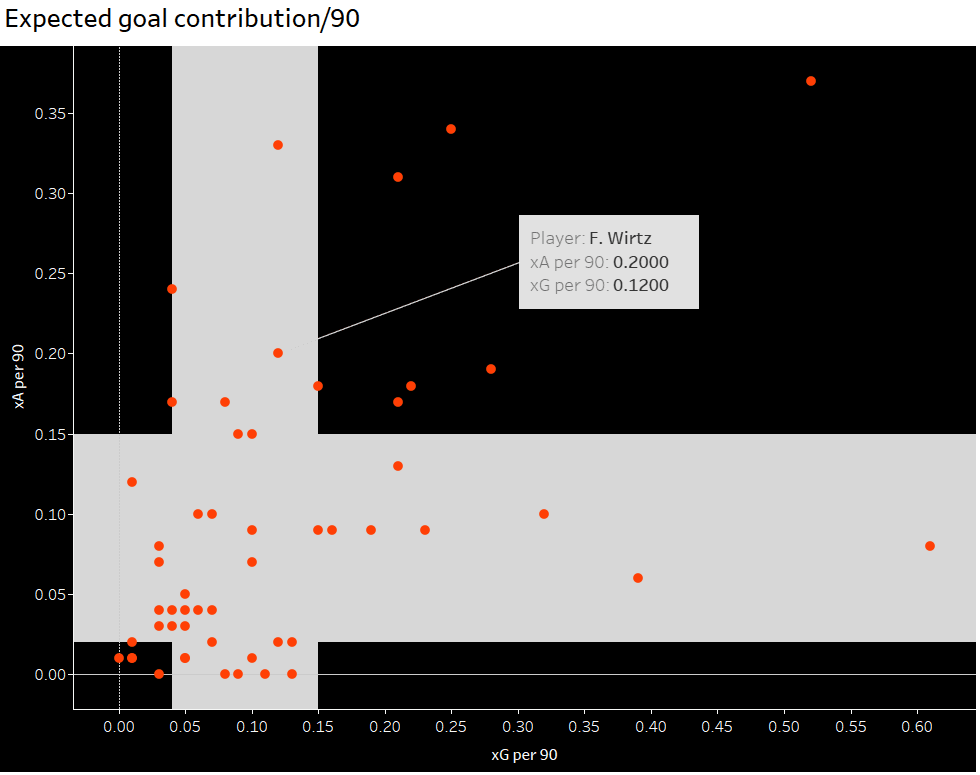
Wirtz has an xG per 90 of 0.12 and an xA per 90 of 0.20, giving him an expected goal contribution total, in the Bundesliga only, of 0.32. This is still quite impressive, as it means that the 17-year-old is creating chances which should result in at least one goal, either for himself or his teammates, roughly once every three games. If we look at the comparison, Wirtz has performed well above his peers in terms of xA/90 – there are just five players in his position who have played more than 800 minutes and are logging a higher xA/90 tally at the moment in the Bundesliga. He is around the average for xG/90, but that still represents quite an encouraging start to his Bundesliga career. Wirtz is already making things happen at the business end, in terms of goals and assists, as we saw above, and the underlying numbers are not too far off either, suggesting that while this level of output may not be sustainable, he will still produce goals and assists at a healthy rate.
Another important metric to look at in terms of attacking midfielders is the threat they offer inside the opponent’s penalty area. This can be seen through two stats – passes to the penalty area per 90 and touches in the box per 90. This also helps us understand the player’s profile to an extent – is he someone who looks to get into the box frequently, or is he more of a creator, attempting to find teammates in dangerous positions?
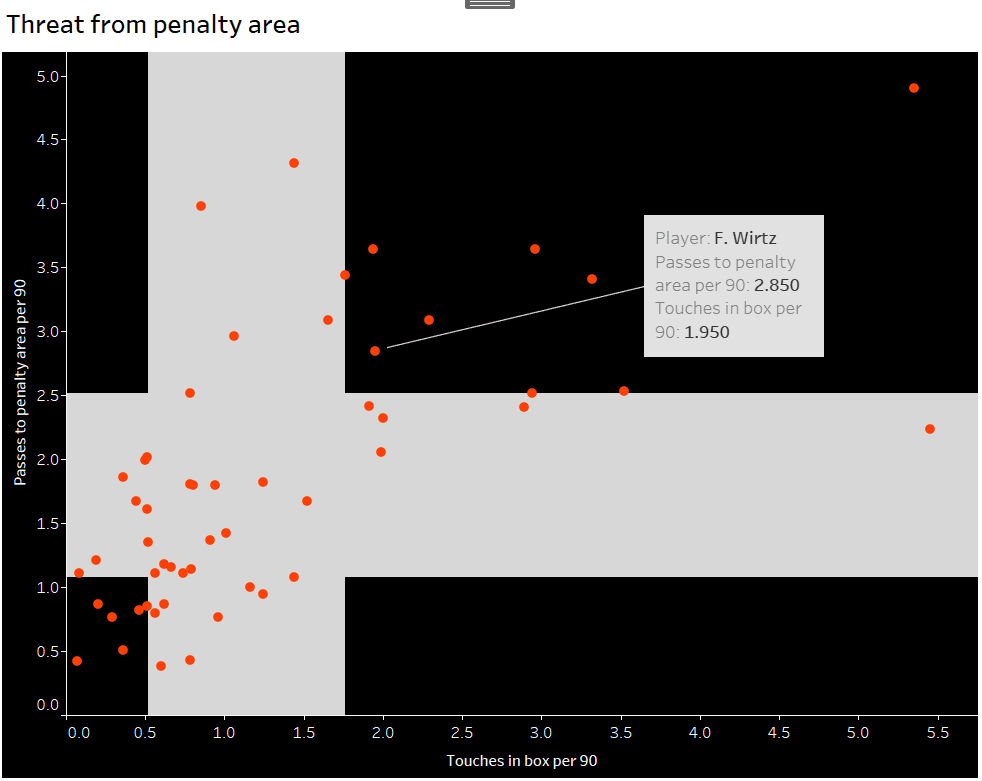
Once again, we see that Wirtz has been one of the top performers in the Bundesliga based on these metrics. He has averaged 2.85 passes to the penalty area per 90 in the league so far, while also getting 1.95 touches per 90 in the box. There are very few players who manage to do both of these at a relatively high volume, as can be seen from the chart, where once again there are only five players accompanying Wirtz in performing much better than average for both metrics. He is perhaps more inclined to make passes into the box rather than get into those areas himself, but only slightly so, and as the analysis will show, he is perfectly capable of getting into the box himself to score or set up teammates, as well as picking them out from outside the box.
These charts have given us a fair indication of Wirtz’s talent, in that he has managed to put up numbers rivalling some of the best creators and attacking midfielders in the Bundesliga in his first full season. The analysis now will look at Wirtz’s traits and strengths through in-game examples.
In Possession
Passing
Wirtz is an extremely creative player in possession, and his passing stats bear this out as well. The 17-year-old makes 42.10 passes per 90 on average, at a relatively low accuracy rate of 78.74%. However, the reason for this is that a large number of his attempted passes are difficult, clinical passes which would open up the opposition defence if successful. He makes 10.88 forward passes per 90, at an accuracy rate of 61.42%, illustrating the fact that Wirtz often attempts the difficult pass. Of course, he does need to improve his decision-making, since he often ends up losing possession through such attempts, but this will come with time and experience – it must be remembered that he will not even turn 18 for nearly four months yet, at the time of writing. What is encouraging that he already has the vision to see such passes, and the bravery to attempt them – both of which will be invaluable as he matures and learns to pick his moments.
He is extremely comfortable both on the transition as well as in established phases of possession, although it must be said that he is quite good at finding runners into space, and this has been seen already in quite a few games for Leverkusen this season –
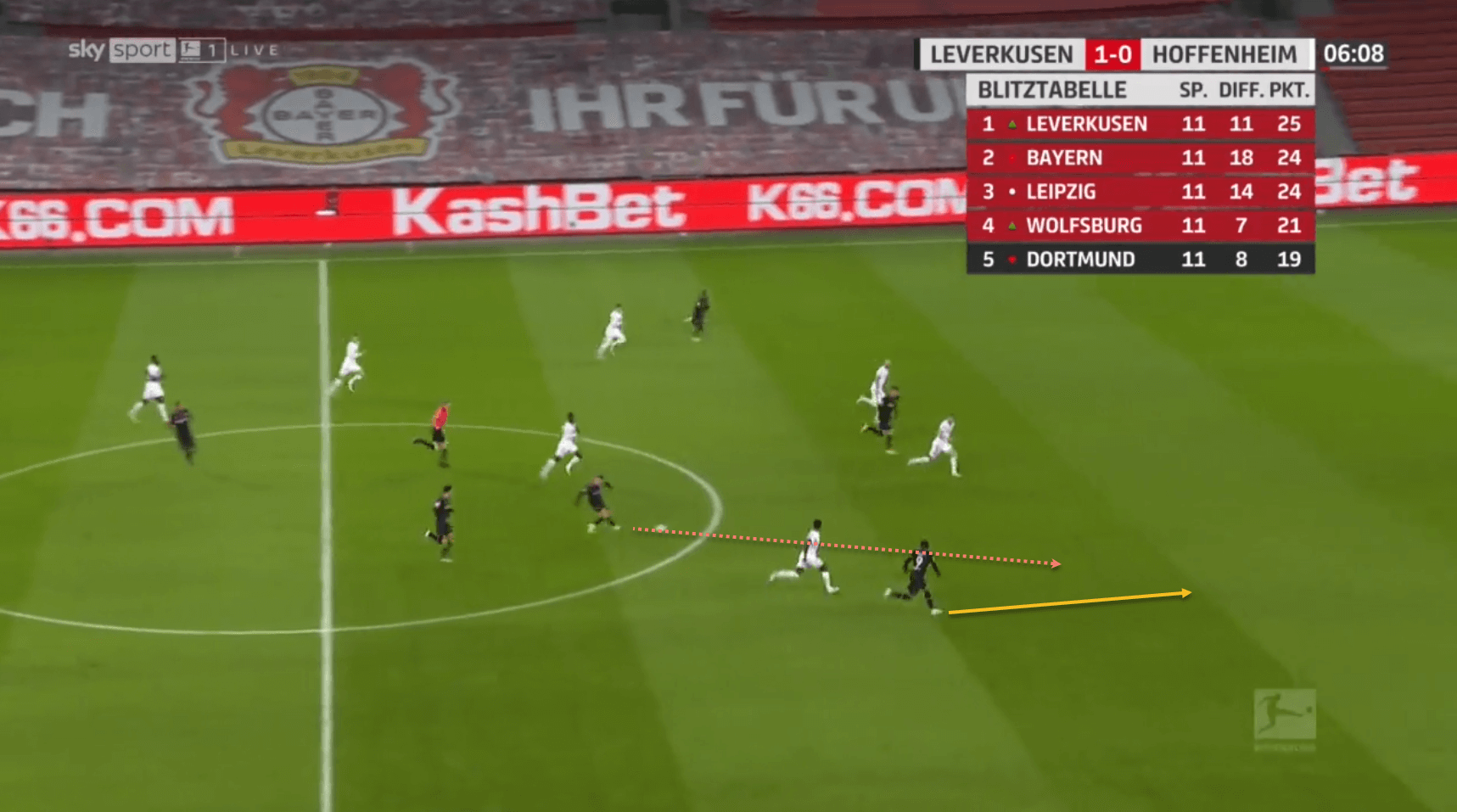
Here, Wirtz is able to find Leon Bailey with a pass behind the defence while on the run himself.
Of course, he is also quite capable of picking locks and threading passes through the eye of the needle, so to speak…
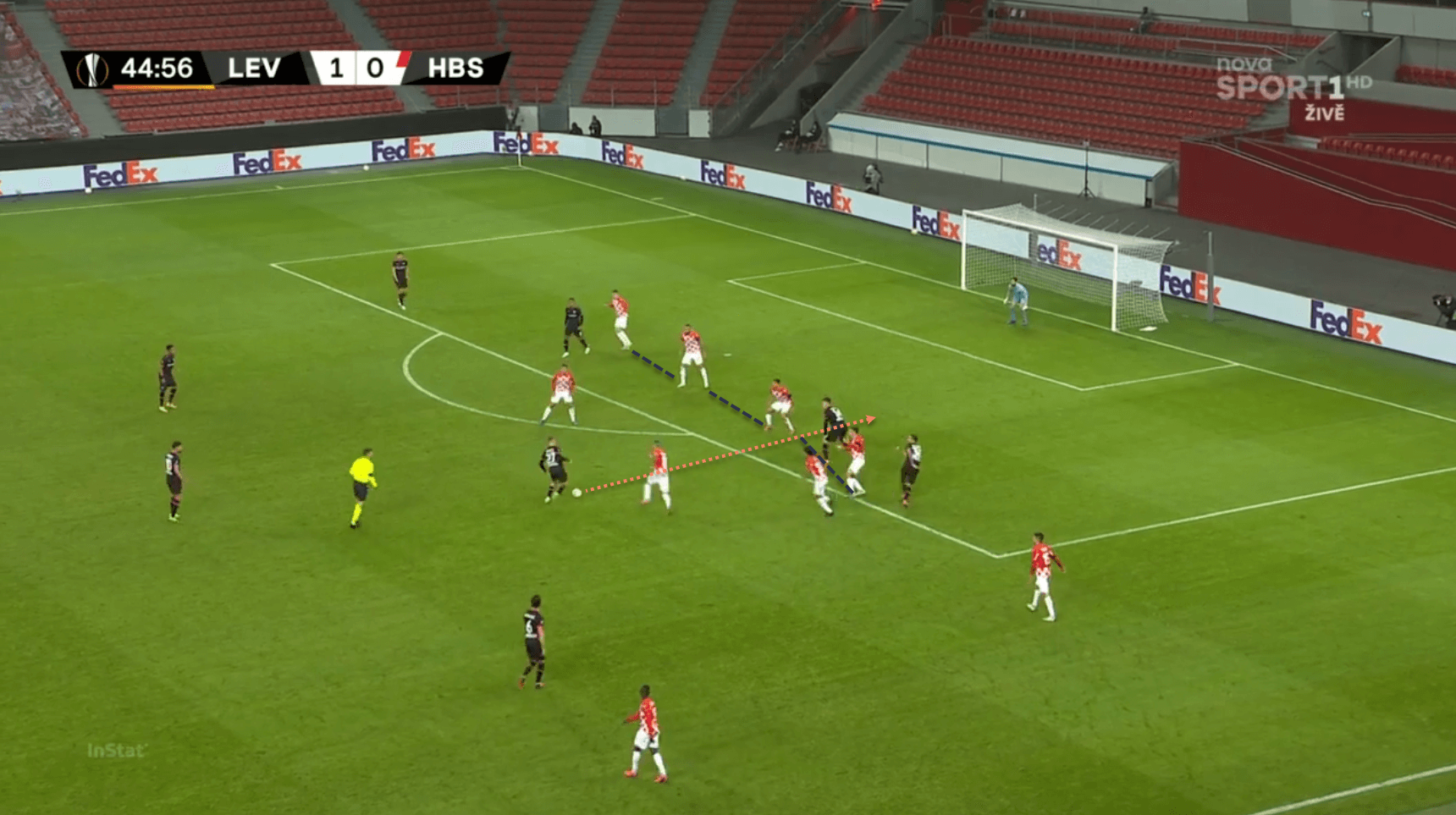
Here, Wirtz manages to place a pass through a very small gap in the Hapoel Be’er Sheva defence, only for Patrik Schick to be caught on his heels and unable to catch up with the ball.
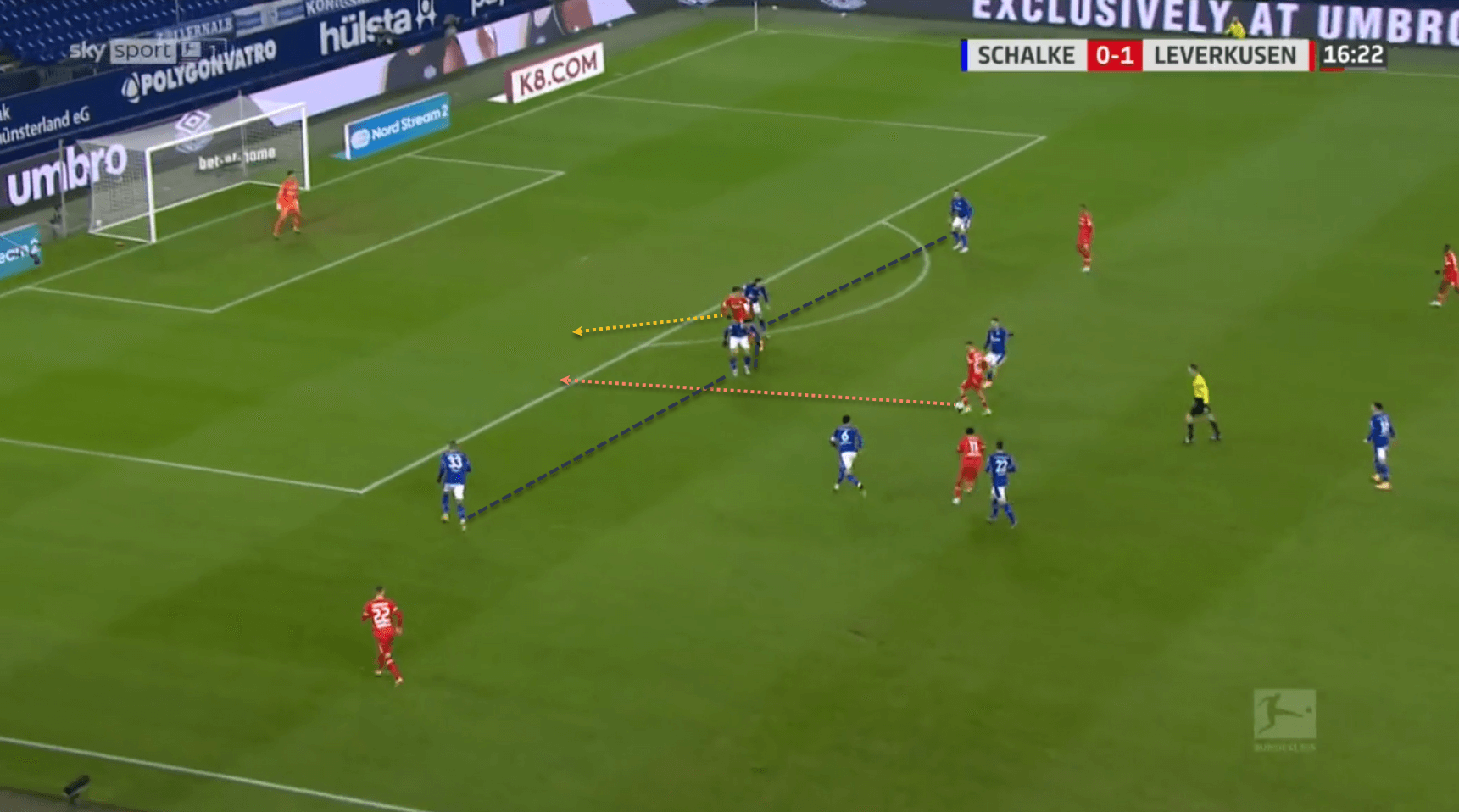
Another example of a similar pass, this time against Schalke in the Bundesliga. Note the similarities to the previous image – Wirtz is being rapidly closed down and manages to time his pass perfectly to ensure that his teammate is not offside, and once again is able to find a relatively small gap with ease.
These examples show that Wirtz is perfectly capable of finding teammates in space, whether on the counter-attack or in more established phases of possession. He does need to cut down on his frequency of attempting such passes to improve his ball retention, but this is a requirement for Peter Bosz’s style of play, which focuses on verticality and rapid attacks. In that sense, Wirtz is merely playing to his manager’s instructions, and doing a very good job at that.
Dribbling
Another area where the 17-year-old is fairly competent at the moment is dribbling. He has attempted 3.92 dribbles per 90 in all competitions for Leverkusen so far this season, at a 45% success rate, showing that this is not necessarily one of his strong suits. Nevertheless, he does possess quick feet, and can get away from opponents with a quick burst of speed when needed. This, along with his composure, allows him to be able to get out of opposition challenges on occasion and then drive into space, as this next example shows –
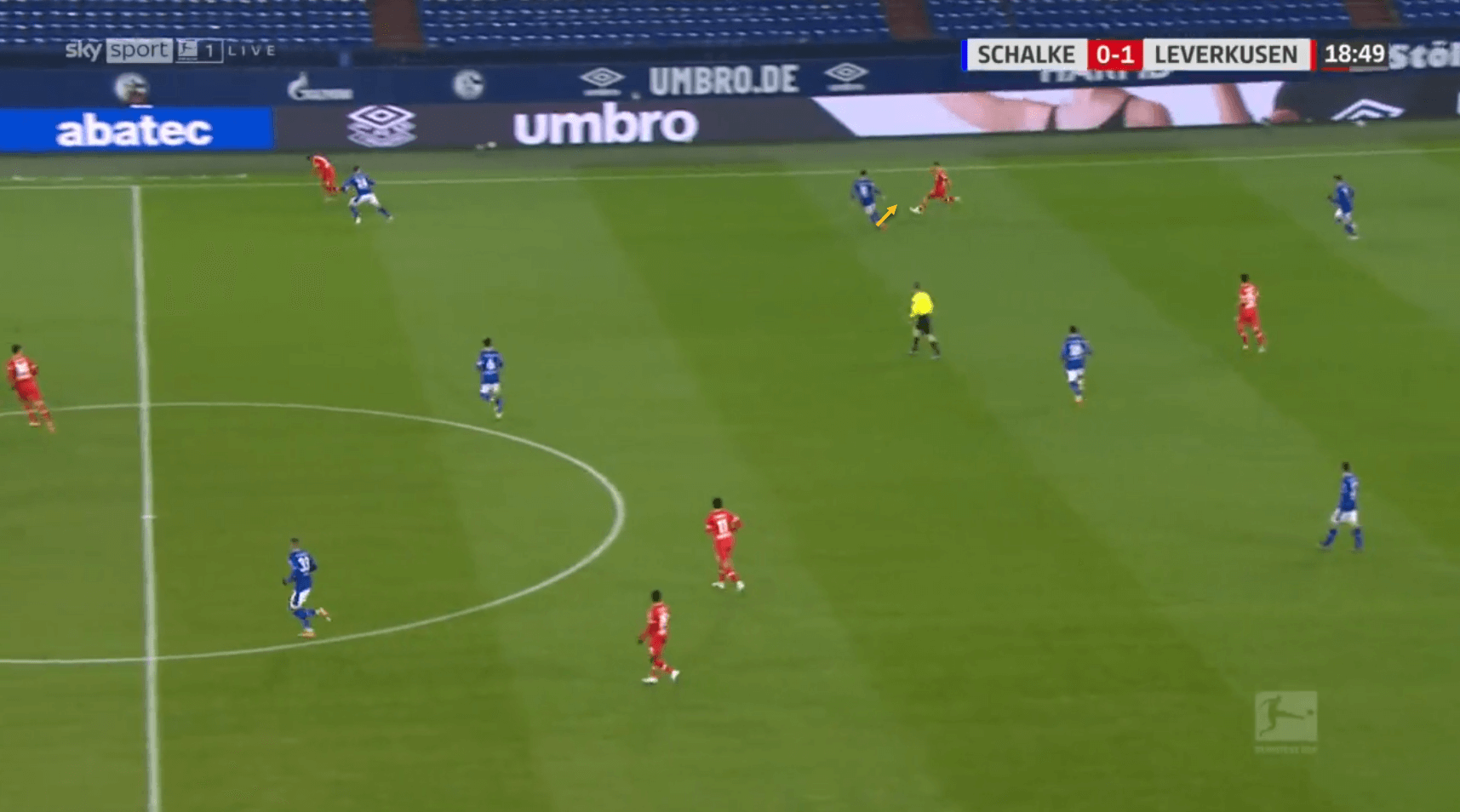
Here, Wirtz has the ball deep in his own half, with a Schalke player rushing in to challenge and potentially win the ball back in a dangerous area.
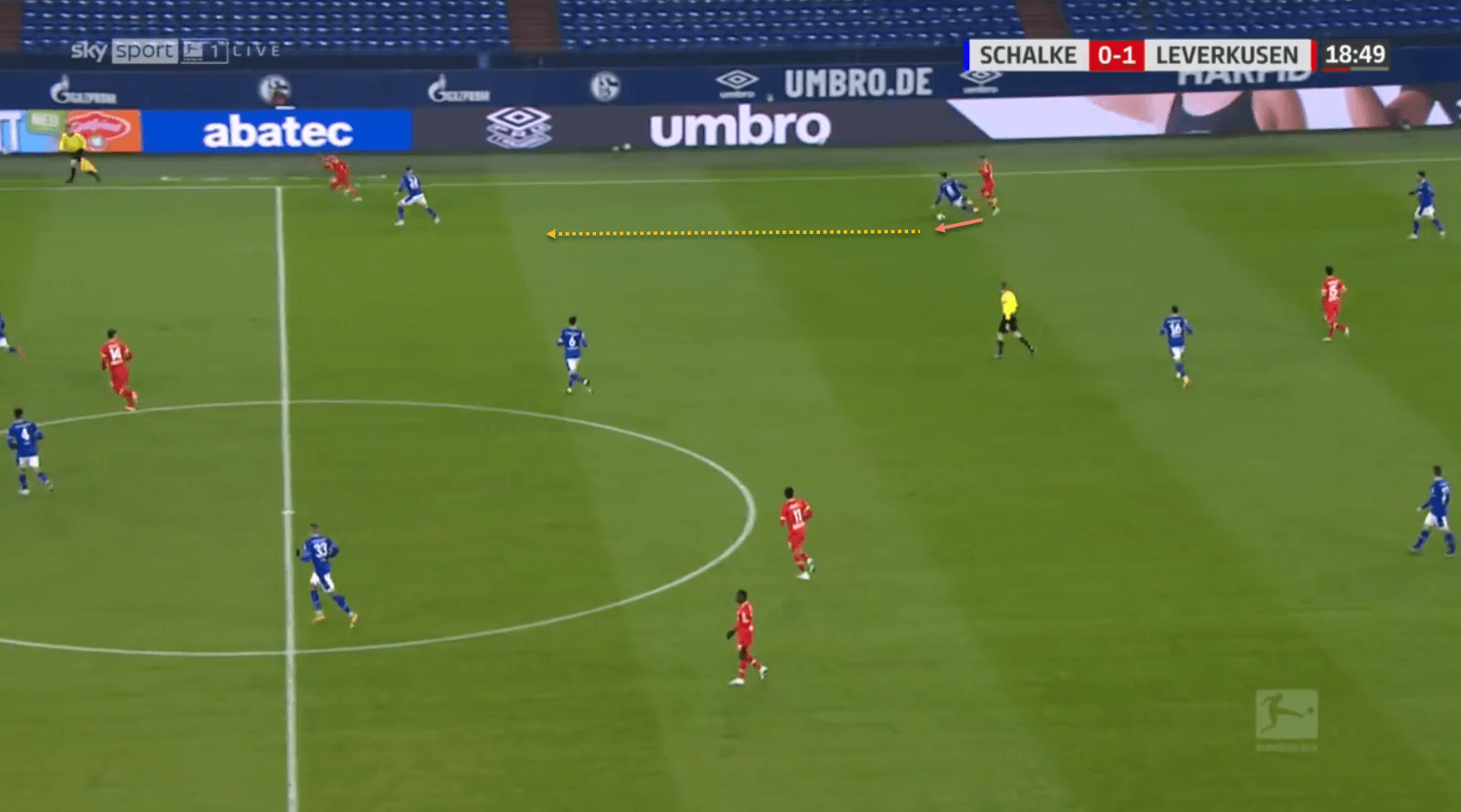
However, Wirtz has read this, and manages to slip the ball past the challenge, which then leaves him with a lot of space to run into and set up a Leverkusen attack.
Again, like his tendency to look for the defence-splitting pass, this is something that can be worked on and improved on the training ground, but it is encouraging that he does seem to have the raw materials to get away from opposition players when needed.
Movement and positioning
These are arguably Wirtz’s biggest strengths, and are a big reason for his aforementioned ability to get away from opposition markers. Despite such a young age, the German is extremely intelligent in terms of the space he finds on the pitch, positioning himself between the opposition’s lines to pick up the ball and then turn and either pass or drive at the retreating defence.
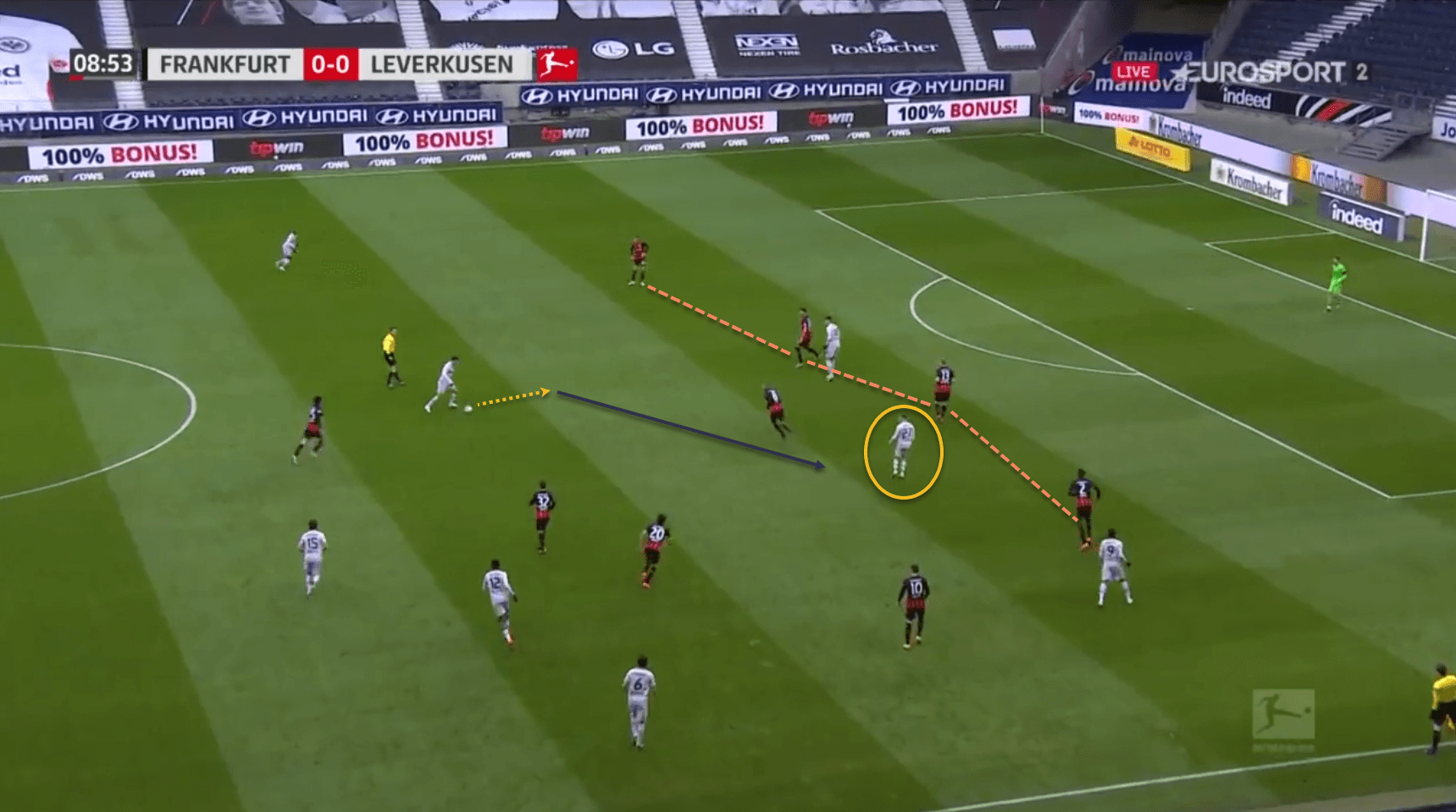
Notice how he has managed to float into an extremely threatening position here, with the Frankfurt defence holding their line, but the midfield all over the place. This allows his teammate to find him in space, from where he can then look for options in the final third.
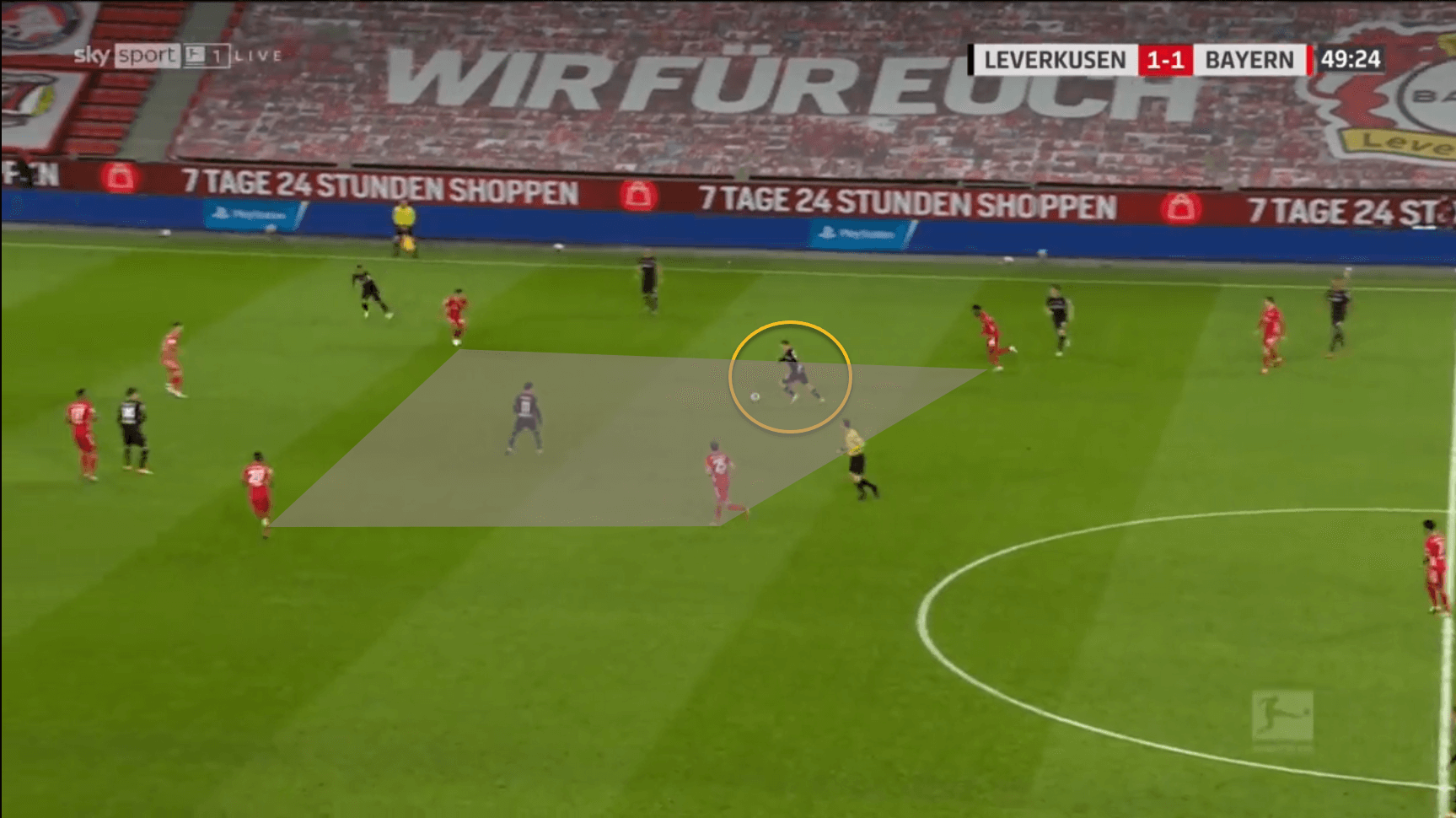
Another example of this, against Bayern Munich, and one where he picks up the ball in space in a deeper area of the pitch, but one that is no less threatening due to the high line that Bayern are playing, and therefore the potential for Wirtz to find a teammate making a run in behind.
A large part of this is down to the youngster’s movement to get away from markers. Wirtz is adept at checking one way and then moving in the other to fool markers and gain the space he needs to then pick a pass or attempt a dribble –
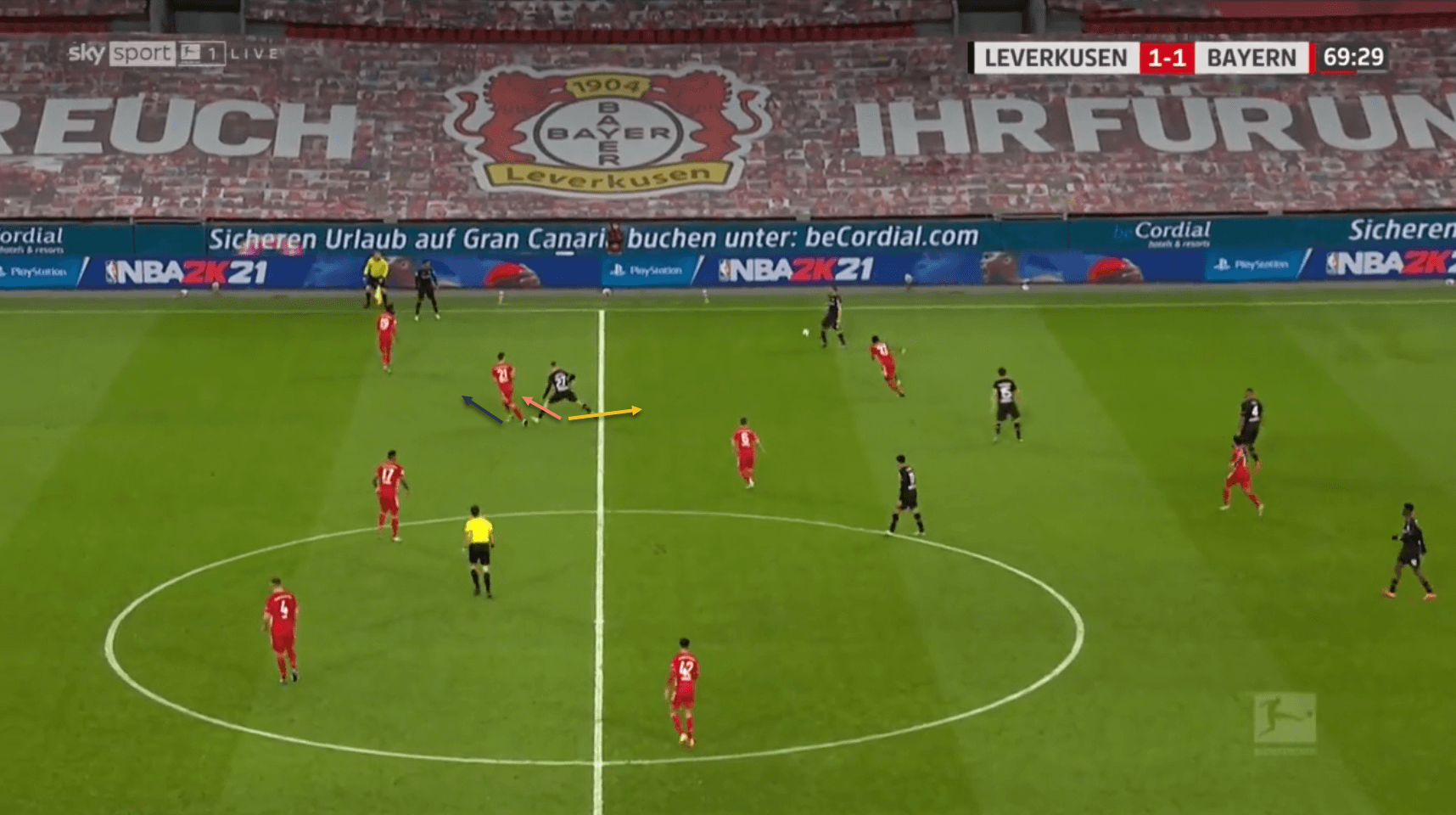
Here, Lucas Hernandez is moving deeper to track Wirtz, who makes a quick dart away from him at the last moment as his teammate looks to release the ball…
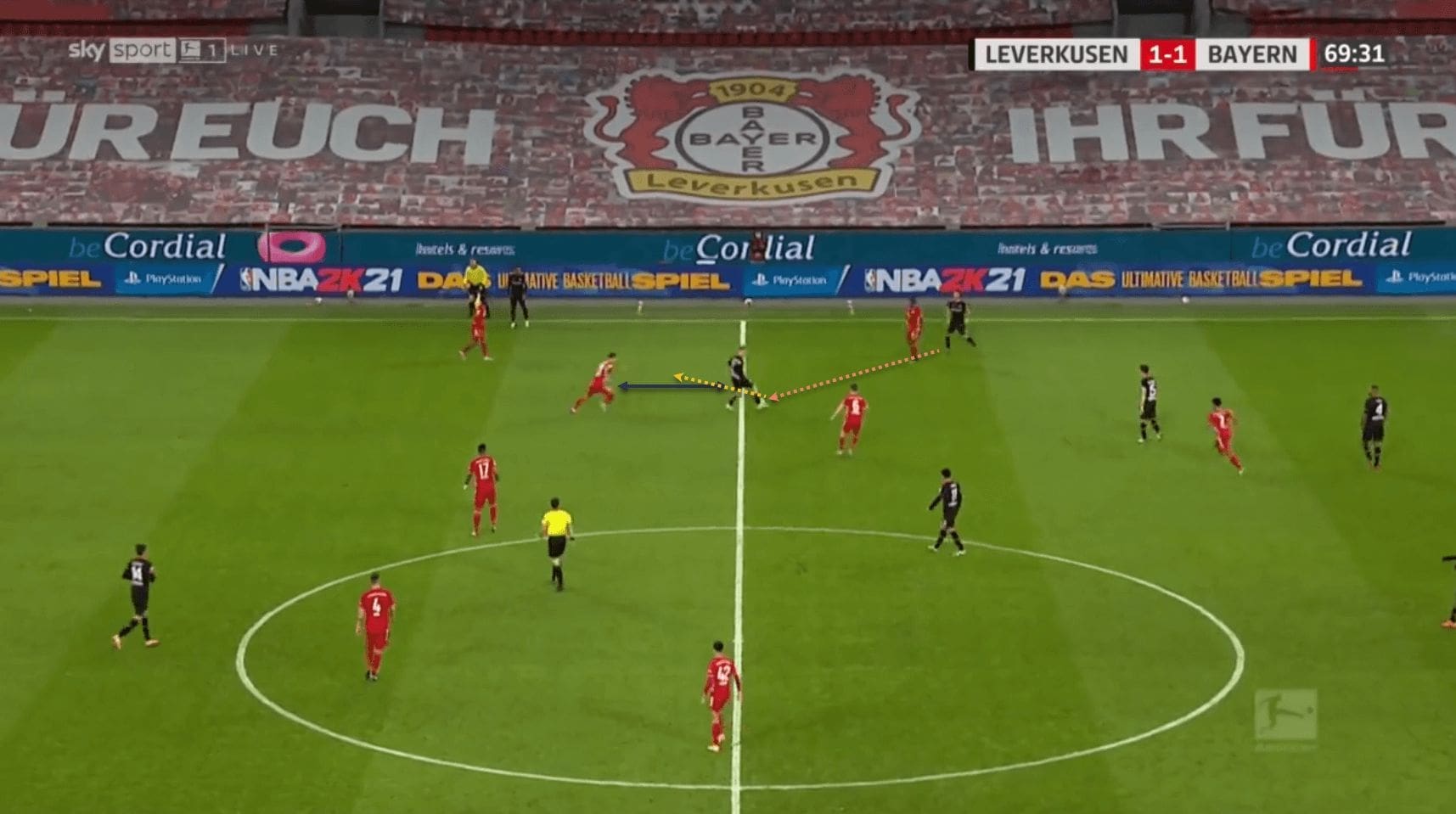
This sends Hernandez the wrong way and allows him to receive the ball in space, turn past the recovering Frenchman and accelerate into space.
Wirtz also has a tendency to drop deep from higher up the pitch to receive the ball, which drags markers out and creates space for himself or for his teammates.
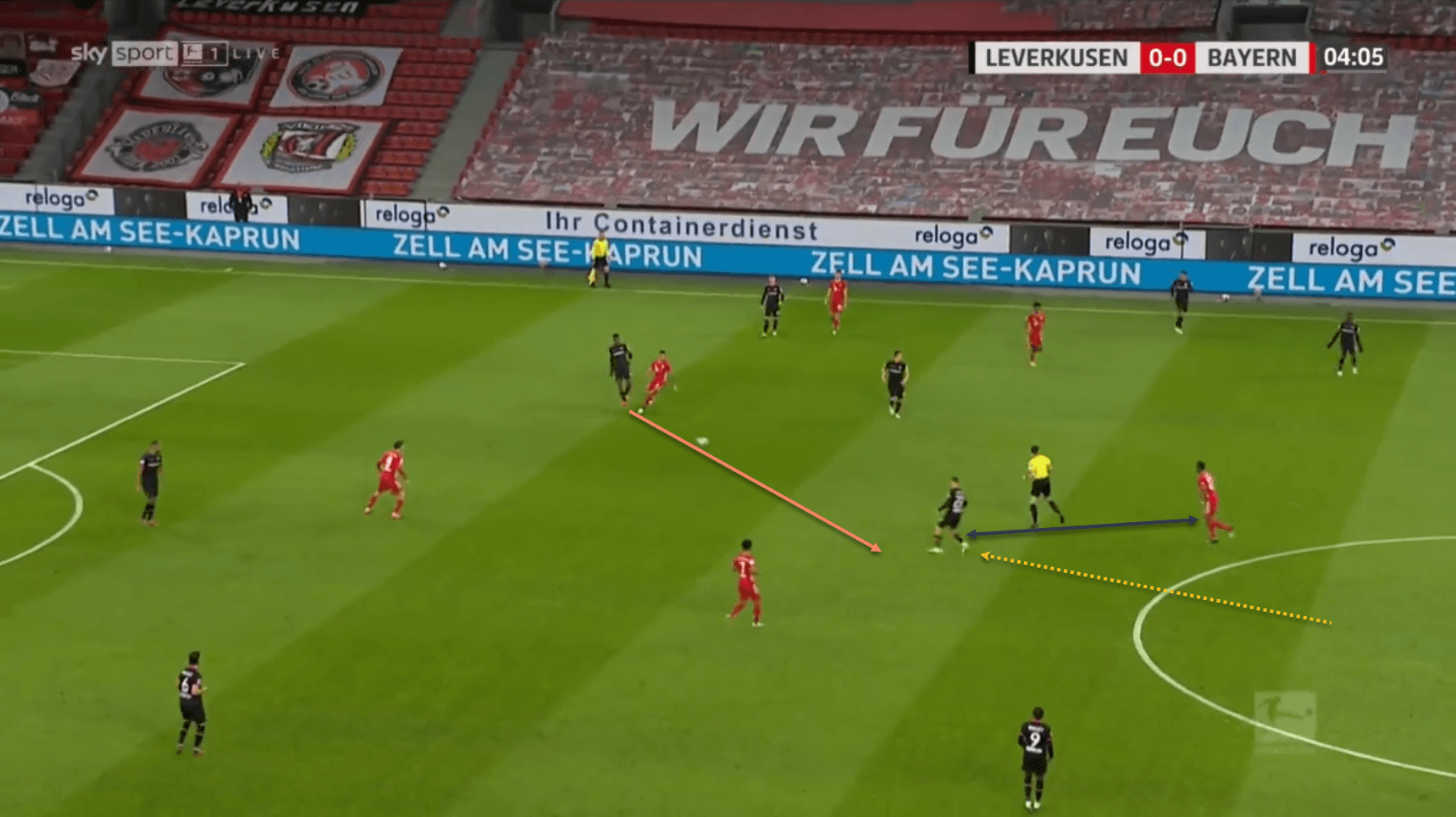
Once again against Bayern, we see the 17-year-old dropping from the centre circle, which has belatedly dragged David Alaba towards him, although he remains in a lot of space to receive the ball.
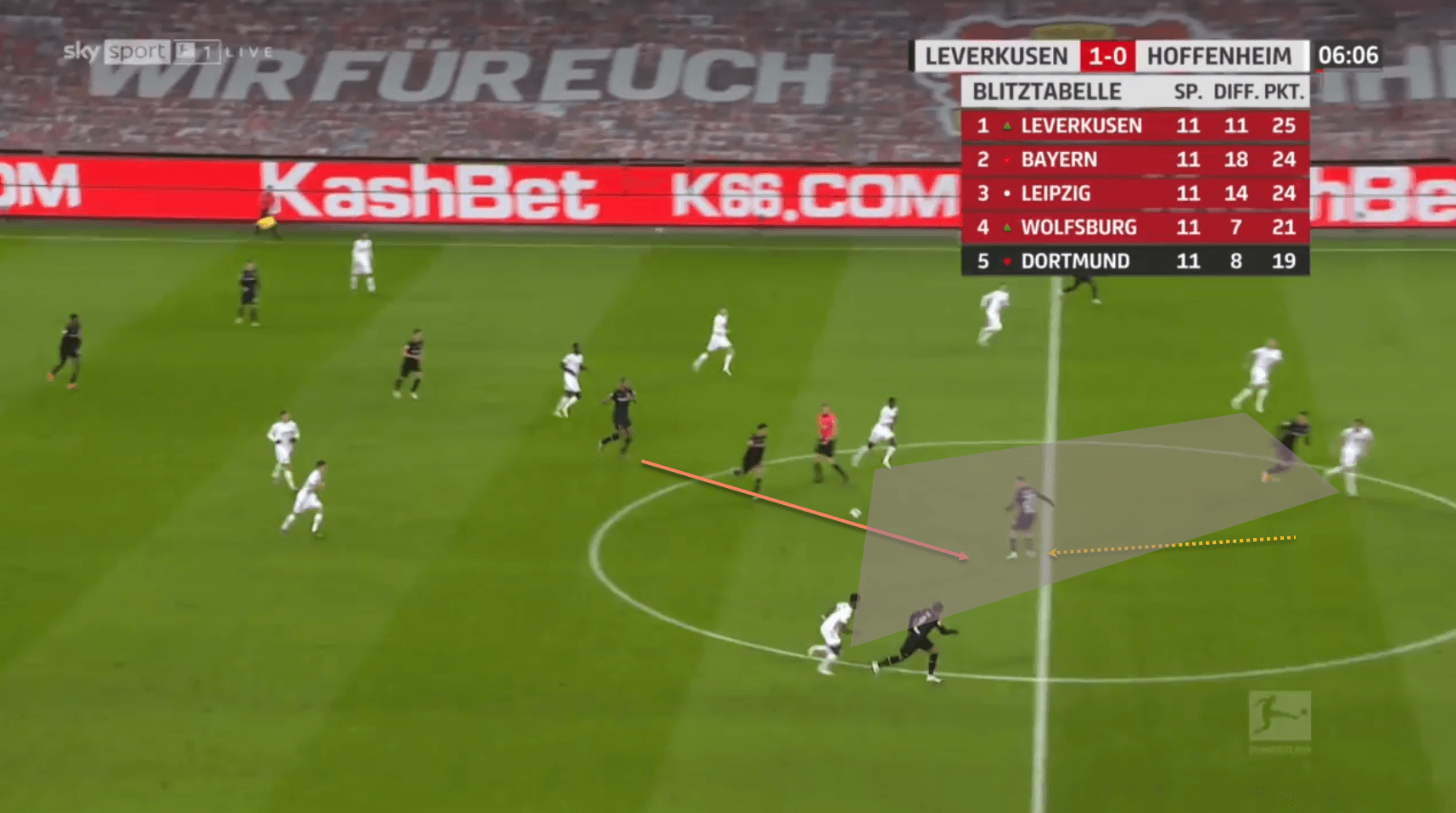
Another instance of this against Hoffenheim, where his movement has allowed him to pick up the ball in space between the retreating opposition defence and midfield.
Once again, it is impressive that a 17-year-old is already showing such good movement and spatial awareness. These are traits that can be improved upon on the training ground, but having some sort of natural ability or aptitude for them is vital, and Wirtz has shown this in spades so far this season. These traits are crucial to being a top-level playmaker, which is where Wirtz looks to be headed.
Off the ball
Bosz’s Leverkusen side are renowned all over Europe for their pressing intensity and energy, even though they may have dropped off slightly this season, as most teams have, due to the physical effect of playing so many matches in such a short span of time, and the extremely short turnaround between last season and this one. Nevertheless, players in Bosz’s system need to be intelligent in their pressing, knowing when to chase and when to hold and block passing lanes, and it seems as though this is another facet of the game that Wirtz has down pat.
He is quite active defensively, as seen by the fact that he has made 2.7 possession-adjusted (PAdj) interceptions per 90 in the Bundesliga so far this season, while also making 5.03 recoveries per 90, of which nearly 55% take place in the opposition half. Wirtz has been integral to Leverkusen’s press, and the following examples will show that he is quite intelligent during his attempts to win the ball back.
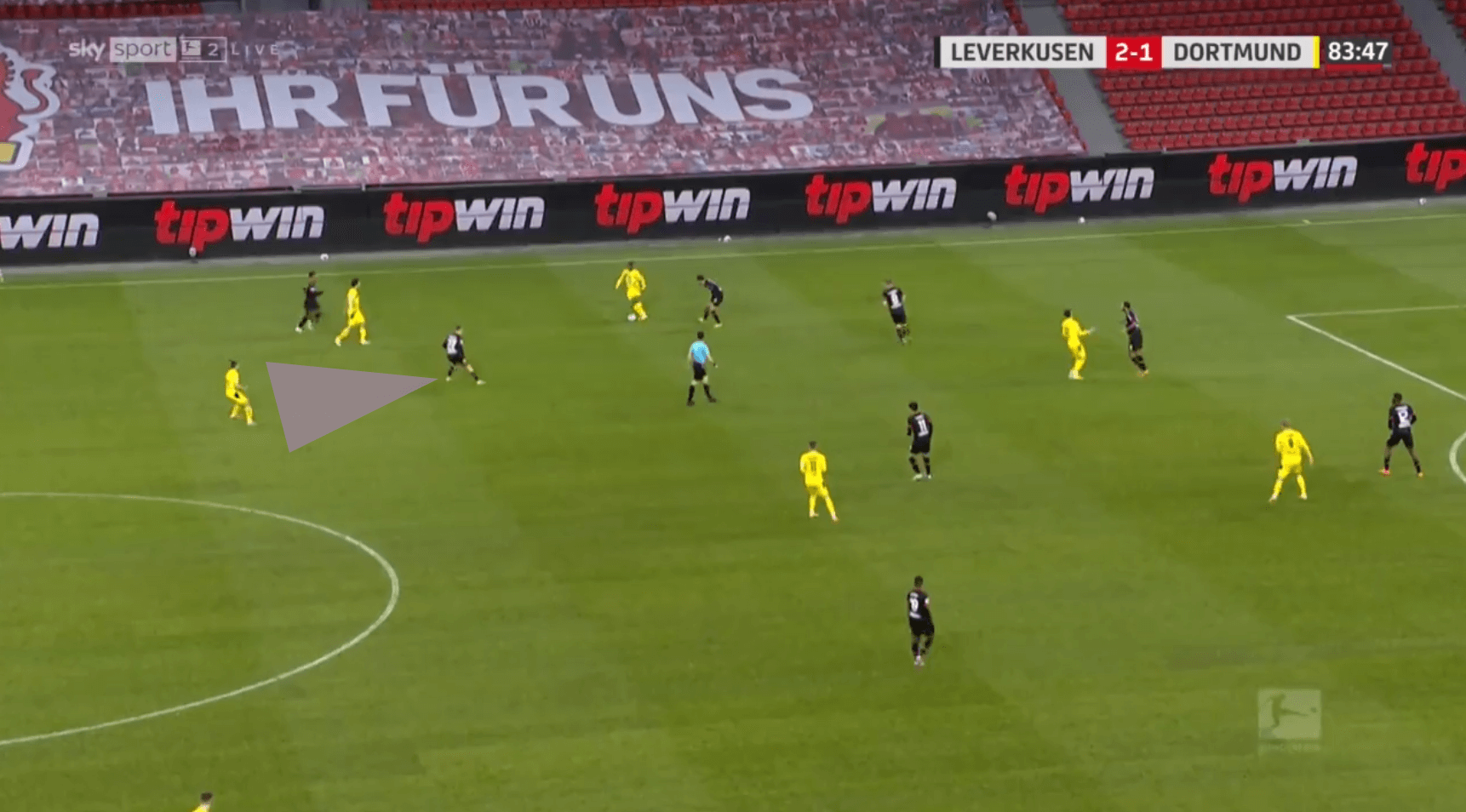
One of Wirtz’s strengths seems to be knowing when to press and when to block the passing lane. Here, as Moukoko picks up the ball, Wirtz does not advance to close him down, instead blocking the pasisng lane to his teammate.
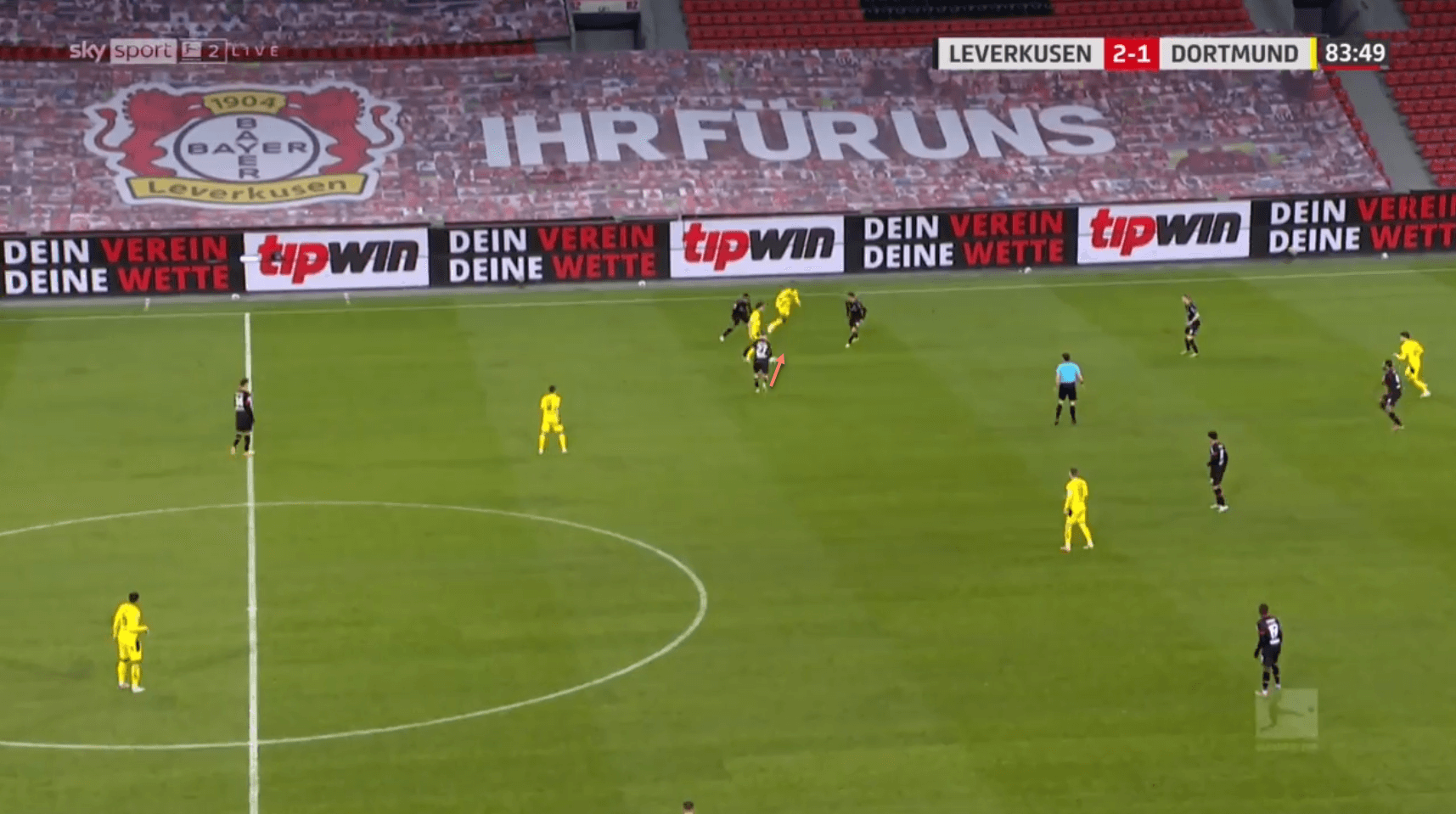
It is only when the ball is played to Thomas Delaney that Wirtz presses the Dane, and wins the ball back.
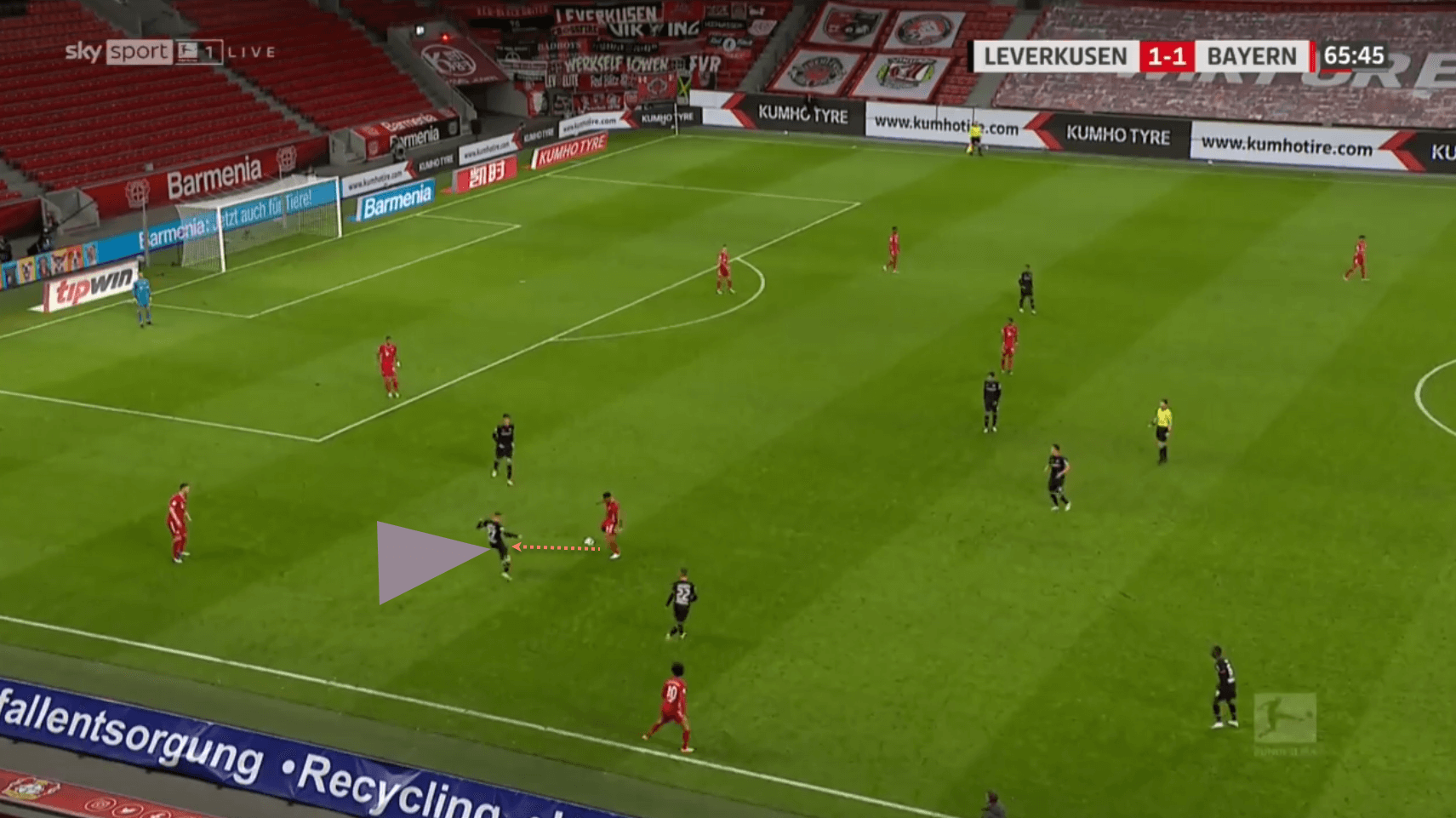
Another example, against Bayern this time, where Wirtz has blocked Alaba’s pass back to Niklas Süle, and thus successfully intercepts the attempted pass, even though Bayern swiftly regain possession.
Making his breakthrough in the Leverkusen side under Bosz has helped the German youngster hone and improve his pressing skills, and this will be an extremely important part of his repertoire as he progresses, with more and more teams demanding a lot more work-rate and intelligence off the ball from all their players.
Conclusion
Florian Wirtz, despite being 17 years only, has managed to hold his own in the dazzling lights of the Bundesliga, to the extent that Leverkusen have not been hurt too hard by the departure of Havertz to Chelsea. The playmaker has shown intelligence and maturity beyond his years, as well as an abundance of technical skill, and there is a very high ceiling to his development given his young age. It will be extremely interesting to track his progress as the season goes on, having already become a central part of a Leverkusen side challenging for a Champions League spot next season, and he has also made the step up to the German U-21 side last year, so do not be surprised to see him turning out for Die Mannschaft sooner rather than later.





Comments